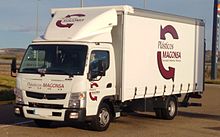Tautliner
The tautliner , also English curtainsider , German sliding tarpaulin or side tarpaulin , is a construction form of trucks , semi-trailers or trailers with a side tarpaulin , and is used in freight transport .
The term
The term is made up of the English words taut for "tense" or "tight" and liner in the broadest sense for "means of transport". The German name is Schiebeplanenauflieger , curtainsider trailer respectively Schiebeplanen- or side tarpaulin (as translated from English Curtainside ).
Originally, Tautliner was a brand name of the British commercial vehicle manufacturer Boalloy Industries Ltd. from Congleton . Haulier Eddie Stobart had the idea of using such a sliding tarpaulin to load the semi-trailer from the side . The side curtains, which could be stretched with buckles close to their lower edge as a sliding tarpaulin, were designed by Derek Lawrence. The company Boalloy Industries Ltd. built this type of semi-trailer and applied for a patent for this type of vehicle in 1969 under the name Tautliner . Today, however , the name Tautliner is also used as a generic name for curtainsider trailers from other manufacturers.
The traffic law designation is Seitenplanen (Curtainsider) ( body type - supplement code 06 according to Regulation (EU) 2018/858 ).
The structure
The semi-trailer as a tautliner is not equipped with side walls, but - from a certain length - with vertical, removable stanchions and support slats inserted horizontally in the mountings and with a lateral tension tarpaulin (curtain tarpaulin , side curtain) on the left and right. This can be easily and quickly pushed on or opened using the handle loops using the small upper rollers. It is lashed or tensioned on the sides with small tension belts (tensioning buckles) on the lower side of the trailer floor, whereby these grip into a rail edge with the help of hooks. The running rail attached to the roof structure of the semi-trailer is also the upper roof frame. The semi-trailer is often provided with a foldable roof that can be pushed open with a rod like a sliding roof. The roof structure is connected at the front with the fixed front wall, and the upper elongated aluminum frame has around three movable stanchions that are connected to the roof rack and give the roof structure the necessary stability. The rear rigid door frame is also connected to the trailer roof at the top. The two solid aluminum doors are held against it. The structure of the loading area of a tautliner mostly consists of a stable wooden floor, either of the conventional type with wooden planks, or more recently mostly of multilayer, glued screen printing plates .
Tension straps are integrated on the lower edges of the sliding tarpaulin . It should be noted here that these straps are only used to close and tension the tarpaulin, but do not represent straps in the sense of load securing aids. The sliding tarpaulins can be pulled up like a curtain . This simplifies handling and speeds up the loading and unloading process.
Advantages over normal semi-trailers:
- easy opening, sliding and closing of the tarpaulin for loading and unloading (time saving)
- Lateral loading length of the trailer increases
- the trailer can be loaded continuously from the side because there are no stanchions
- Avoidance of accidents when planning and unloading vehicles (ladder accidents)
- Roof bars ( stanchions ) can be adjusted
The side tarpaulins are sometimes stiffened with aluminum slats, which reduces flutter in the airstream and the risk and consequences of a tarpaulin tearing. The terms Speed Curtain , Curtainsider and Easy Tarp are also used by the manufacturers Fliegl , Kögel , Krone , Schmitz and Wielton .
Other structures
In contrast to the Edscha body , with the Tautliner, both side tarpaulins and the roof can be opened separately. Other designs are, for example, the box body and the covered wagon as a tarpaulin / bow structure with foldable side walls.
The sliding tarpaulin concept also applies to railway wagons , see Covered Freight Cars .
Web links
Individual evidence
- ↑ a b c Hunter Davies: The Eddie Stobart Story . HarperCollinsEntertainment, London 2001, ISBN 0-00-711597-0 .








